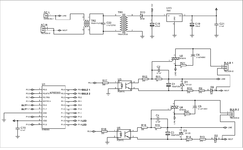gauravkothari23
Advanced Member level 2

Hi all.
I am trying to control the 24 watts LED Bulb using a Triac and microcontroller. (Circuit Attached)
i am Using PC817 to control the triac On and OFF.
I am using 2 Triac to control 2 LED Bulbs. and to make it isolated i am using optocoupler PC817.
I have two buttons on circuit which are not shown.
The two buttons are used for switching the BULB 1 and BULB 2 ON or OFF
My problem is when i switch BULB 1 ON, BULB 2 also goes ON, or when i switch BULB 2 ON, BULB 1 also goes ON.
As i have noticed that when i remove the load BULB 1 and then switch BULB 1 ON, the BULB 2 does not GLOW. but when both the BULBs are connected and i switch any one BULB, then BOTH the bulbs goes ON.
can anybody please suggest me where the problem is.
I have even checked for any track shorts. but i did not find any.

I am trying to control the 24 watts LED Bulb using a Triac and microcontroller. (Circuit Attached)
i am Using PC817 to control the triac On and OFF.
I am using 2 Triac to control 2 LED Bulbs. and to make it isolated i am using optocoupler PC817.
I have two buttons on circuit which are not shown.
The two buttons are used for switching the BULB 1 and BULB 2 ON or OFF
My problem is when i switch BULB 1 ON, BULB 2 also goes ON, or when i switch BULB 2 ON, BULB 1 also goes ON.
As i have noticed that when i remove the load BULB 1 and then switch BULB 1 ON, the BULB 2 does not GLOW. but when both the BULBs are connected and i switch any one BULB, then BOTH the bulbs goes ON.
can anybody please suggest me where the problem is.
I have even checked for any track shorts. but i did not find any.

